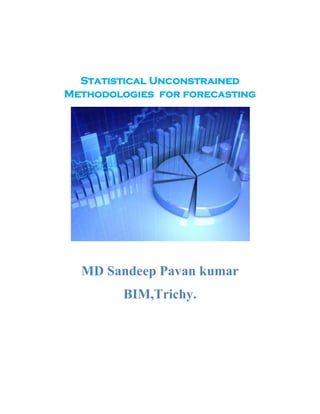
Unconstrained Methodologies
- 1. Statistical Unconstrained Methodologies for forecasting MD Sandeep Pavan kumar BIM,Trichy.
- 2. In airline/hotel Industry When the limits for a particular class are reached, the respective classes are closed and as a result, further demand information for these classes is lost. In statistics this is called censored or constrained data. To overcome these problems, it is necessary to extrapolate the true demand distribution parameters from censored booking data before putting them into the forecasting models. In the airline and hotel industries, this process is called demand unconstraining. Demand unconstraining function is to provide true demand information for forecasting models. It usually contains two steps. First, through examining similar historical bookings that have not been censored, one derives unconstrained demand parameters. These parameters then are applied to estimate unconstrained historical demand. Unconstraining Can be done in the Following Ways (1) Directly observe and record latent demand, (2) Leave data constrained, ignoring the fact of censorship, (3) Use unconstrained data only and discard censored ones, (4) Replace censored data using imputation methods, (5) Statistically unconstraint the data. But this paper concentrates on Statistical Methods There are three types of Averaging methods (AM), Booking Profile Method Projection Detruncation (PD) Expectation Maximization (EM).
- 3. Averaging method (AM) Averaging Method is used when there is no trend or season. In this method, the most systematic component in demand is Level , So we estimate the level in period t as the average demand over the most recent N periods.. This represent N-period moving average. Lt =(Dt+D(t-1)+…..+D(t+N-1) )/N Forecast for future is Ft +n = Lt After observing Demand for period t +1, we revise the estimate as below: Lt = (Dt+1+Dt-+…..+D(t-N+2) )/N Ft + 2 = Lt + 1 Ex: Car Sales Demand Unconstraining using Moving Average , Period(N)=4 Unconstrained Year Quarter Period t Demand Dt Level Demand 0 2008 2 1 8000 2008 3 2 13000 2008 4 3 23000 2009 1 4 34000 19500 2009 2 5 10000 20000 19500 2009 3 6 18000 21250 20000 2009 4 7 23000 21250 21250 2010 1 8 38000 22250 21250 2010 2 9 12000 22750 22250 2010 3 10 13000 21500 22750 2010 4 11 32000 23750 21500 2011 1 12 41000 24500 23750 2011 2 13 24500 2011 3 14 24500 2011 4 15 24500 2012 1 16 24500 In the above example we can’t calculate demand for first three periods because N=4.
- 4. Simple Exponential Smoothing The initial estimate of level L0, is taken to be the average of all historical data. Lt =(Dt+D(t-1)+…..+D(t+N-1) )/N Lt +1 = α Dt +1 + ( 1- α)Lt Ft + 2 = L t + 1 L0 = (8000 + 13000 +23000 + 34000 + 10000 + 18000 + 23000 + 38000 + 12000 + 13000 + 32000 + 41000)/12 F1 = L0 = 22083 Period Year Quarter t Demand Dt Level Forecast 0 22083.3 2008 2 1 8000 20675 22083.33 2008 3 2 13000 19908 20675 2008 4 3 23000 20217 19907.5 2009 1 4 34000 21595 20216.75 2009 2 5 10000 20436 21595.08 2009 3 6 18000 20192 20435.57 2009 4 7 23000 20473 20192.01 2010 1 8 38000 22226 20472.81 2010 2 9 12000 21203 22225.53 2010 3 10 13000 20383 21202.98 2010 4 11 32000 21544 20382.68 2011 1 12 41000 23490 21544.41 2011 2 13 23490 2011 3 14 23490 2011 4 15 23490 2012 1 16 23490
- 5. Double Exponential Smoothing (Holts Model) Here demand component consists of level and trend and so initial level, L0 is found out using linear regression between demand and time period. Dt = at + b Ft+1 = Lt + Tt After observing demand for period t, we revise estimates for level and trend as: Lt +1 = α Dt +1 + ( 1- α)(Lt+ Tt Tt+1 = β (Lt+1 - Lt) + (1- β)Tt Where α is Smoothing Constant for Level β is Smoothing Constant for Trend Demand Period (t) Level (L) Trend (T) Forecast (F) (D) 0 12015 1549 1 8000 13008 1438 13564 2 13000 14301 1409 14445 3 23000 16439 1555 15710 4 34000 19594 1875 17993 5 10000 20322 1645 21469 6 18000 21570 1566 21967 7 23000 23123 1563 23136 8 38000 26017 1830 24686 9 12000 26262 1513 27847 10 13000 26297 1217 27775 11 32000 27963 1307 27514 12 41000 30443 1541 29270 13 31984 14 33526 15 35067 16 36609
- 6. There is another method which is called Winters Model which covers Entire three components of demand i.e level,trend and Seasonality . Life tables (LT), is another methods which is used by Medical and reliability engineering researchers. References: 1)A Comparison of Unconstraining Methods to Improve Revenue Management Systems Carrie Crystal Queenan • Mark Ferguson • Jon Higbie • Rohit Kapoor 2) Unconstraining Methods in Revenue Management Systems: Research Overview and Prospects Peng Guo,1 Baichun Xiao,1,2 and Jun Li1 3) Supply Chain Management Notes by Dr.JayaKrishna
